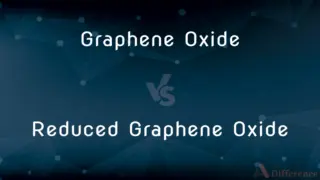Prophase 1 vs. Prophase 2 — What's the Difference?
By Tayyaba Rehman — Published on January 10, 2024
Prophase 1 is a meiosis I stage with homologous chromosome pairing and crossing over; Prophase 2, in meiosis II, involves separated sister chromatids without pairing.

Difference Between Prophase 1 and Prophase 2
Table of Contents
ADVERTISEMENT
Key Differences
Prophase 1 marks the beginning of meiosis I, characterized by chromosome condensation and homologous chromosome pairing. In contrast, Prophase 2 initiates meiosis II, where chromosomes, now without their homologous pairs, begin to condense again.
A key feature of Prophase 1 is the process of synapsis, where homologous chromosomes pair up, facilitating genetic recombination through crossing over. Conversely, Prophase 2 lacks synapsis and crossing over, as homologous chromosomes have already been segregated.
In Prophase 1, the nuclear membrane begins to break down, setting the stage for subsequent phases. Similarly, Prophase 2 witnesses the breakdown of the nuclear envelope, preparing cells for the second meiotic division.
The occurrence of crossing over in Prophase 1 contributes to genetic diversity in gametes. However, Prophase 2 does not involve crossing over, focusing instead on the separation of sister chromatids.
Prophase 1 is typically longer and more complex due to chromosomal pairing and recombination events. Prophase 2, in contrast, is generally shorter and more straightforward, with an emphasis on preparing for the final meiotic division.
ADVERTISEMENT
Comparison Chart
Stage
Beginning of meiosis I
Beginning of meiosis II
Chromosomal Pairing
Homologous chromosomes pair up
No pairing, individual chromosomes
Crossing Over
Occurs, enhancing genetic diversity
Does not occur
Nuclear Envelope
Starts disintegrating
Starts disintegrating again
Duration and Complexity
Longer and more complex
Shorter and more straightforward
Compare with Definitions
Prophase 1
Characterized by genetic recombination through crossing over.
Genetic diversity in gametes is largely due to crossing over in Prophase 1.
Prophase 2
Lacks genetic recombination and crossing over.
Unlike Prophase 1, there's no crossing over in Prophase 2.
Prophase 1
The first stage of meiosis I involving chromosomal pairing.
During Prophase 1, homologous chromosomes undergo synapsis.
Prophase 2
The initial stage of meiosis II without chromosomal pairing.
Prophase 2 starts with individual chromosomes, each composed of two sister chromatids.
Prophase 1
Involves the condensation of chromosomes.
As Prophase 1 progresses, chromosomes become visible under a microscope.
Prophase 2
Sets the stage for the final separation of sister chromatids.
Prophase 2 is crucial for the subsequent separation of sister chromatids in meiosis II.
Prophase 1
Breakdown of the nuclear envelope begins.
The disintegration of the nuclear membrane marks the onset of Prophase 1.
Prophase 2
Another round of nuclear envelope breakdown occurs.
The nuclear envelope disintegrates again during Prophase 2.
Prophase 1
Tetrads form, allowing chromosomal exchange.
The formation of tetrads in Prophase 1 facilitates genetic recombination.
Prophase 2
Chromosomes condense again for the second meiotic division.
Chromosome condensation in Prophase 2 prepares cells for further division.
Common Curiosities
Are both stages part of the same meiotic division?
No, Prophase 1 is part of meiosis I, and Prophase 2 is part of meiosis II.
Do chromosomes condense in both stages?
Yes, chromosome condensation occurs in both Prophase 1 and Prophase 2.
Is the nuclear envelope breakdown a feature of both stages?
Yes, the nuclear envelope starts breaking down in both Prophase 1 and Prophase 2.
What's the main difference between Prophase 1 and Prophase 2?
Prophase 1 involves chromosomal pairing and crossing over, while Prophase 2 does not.
Does the spindle apparatus form in both stages?
Yes, the spindle apparatus begins to form in both Prophase 1 and Prophase 2.
Does crossing over occur in both Prophase 1 and Prophase 2?
No, crossing over only occurs in Prophase 1.
Are Prophase 1 and Prophase 2 part of mitosis or meiosis?
Both are stages of meiosis.
Can Prophase 1 and Prophase 2 occur in somatic cells?
No, they are exclusive to the process of meiosis in germ cells.
Which stage contributes more to genetic diversity?
Prophase 1 contributes more due to the crossing over and recombination.
Does synapsis occur in both Prophase 1 and Prophase 2?
No, synapsis only occurs in Prophase 1.
Are the processes in Prophase 1 and Prophase 2 visually distinguishable?
Yes, under a microscope, the pairing in Prophase 1 and individual chromosomes in Prophase 2 are distinguishable.
Is the end goal of Prophase 1 and Prophase 2 the same?
No, Prophase 1 aims at recombining genetic material, while Prophase 2 prepares for the final meiotic division.
Is the duration of Prophase 1 and Prophase 2 the same?
No, Prophase 1 is typically longer and more complex than Prophase 2.
Do both stages involve the formation of tetrads?
No, tetrads only form in Prophase 1.
Are homologous chromosomes present in Prophase 2?
No, homologous chromosomes are separated by the end of Prophase 1.
Share Your Discovery

Previous Comparison
Graphene Oxide vs. Reduced Graphene OxideNext Comparison
Addition Silicone vs. Condensation SiliconeAuthor Spotlight
Written by
Tayyaba RehmanTayyaba Rehman is a distinguished writer, currently serving as a primary contributor to askdifference.com. As a researcher in semantics and etymology, Tayyaba's passion for the complexity of languages and their distinctions has found a perfect home on the platform. Tayyaba delves into the intricacies of language, distinguishing between commonly confused words and phrases, thereby providing clarity for readers worldwide.











































